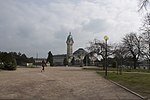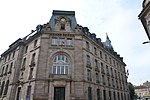France 3 Limousin Poitou-Charentes
France TélévisionsFrench television station stubsMass media in LimogesTelevision channels and stations disestablished in 2010Television channels and stations established in 1965

France 3 Limousin Poitou-Charentes is a former regional television service and part of the France 3 network. Serving the Limousin and Poitou-Charentes regions from its headquarters in Limoges, secondary production centre in Poitiers and newsrooms in La Rochelle and Brive-la-Gaillarde, France 3 Limousin Poitou-Charentes produces regional news, sport, features and entertainment programming.
Excerpt from the Wikipedia article France 3 Limousin Poitou-Charentes (License: CC BY-SA 3.0, Authors, Images).France 3 Limousin Poitou-Charentes
Avenue Guglielmo Marconi, Limoges La Bastide
Geographical coordinates (GPS) Address Nearby Places Show on map
Geographical coordinates (GPS)
| Latitude | Longitude |
|---|---|
| N 45.8575 ° | E 1.2691666666667 ° |
Address
Avenue Guglielmo Marconi
87100 Limoges, La Bastide
Nouvelle-Aquitaine, France
Open on Google Maps







